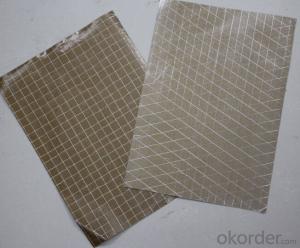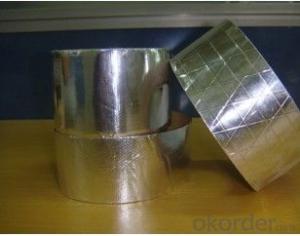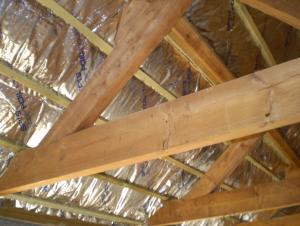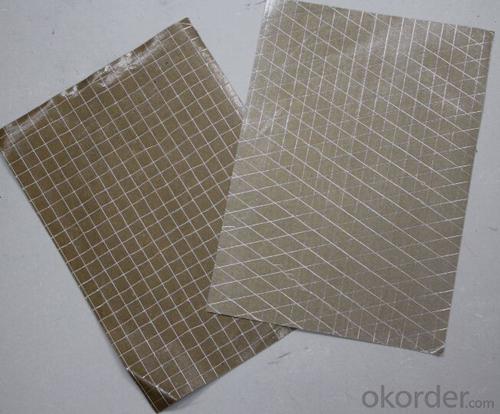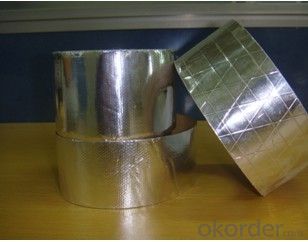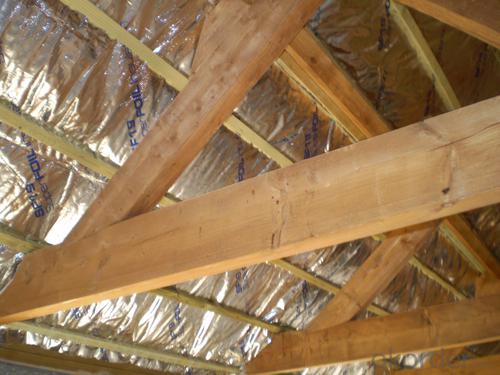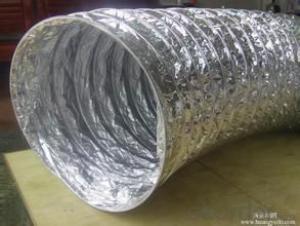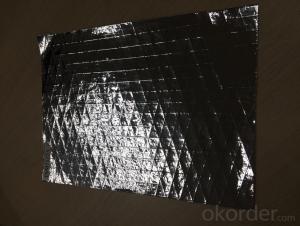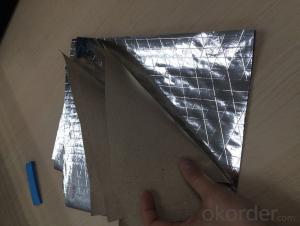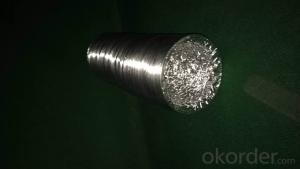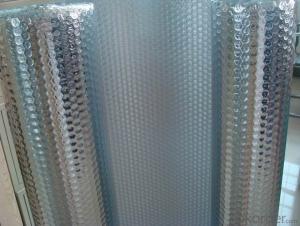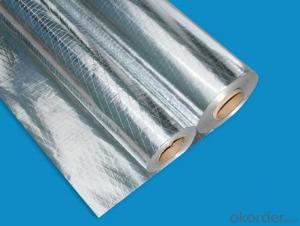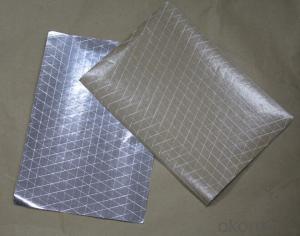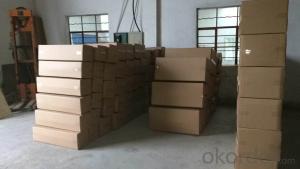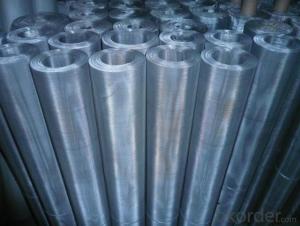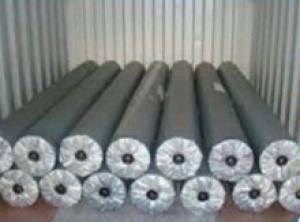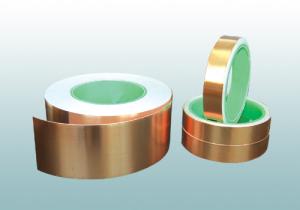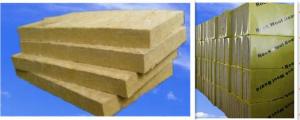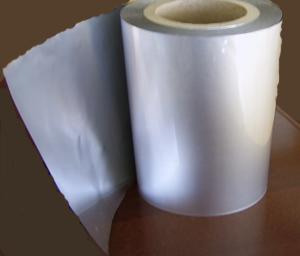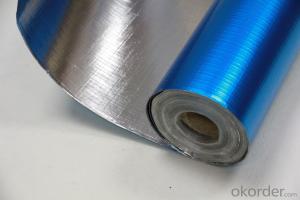Aluminum Foil Facing Flexible Ducts and Bubble Foil AL+PET+LDPE AL+PET
- Loading Port:
- Tianjin
- Payment Terms:
- TT OR LC
- Min Order Qty:
- 12 m²
- Supply Capability:
- 30000 m²/month
OKorder Service Pledge
OKorder Financial Service
You Might Also Like
Specification
1. Aluminum Foil Mylar Description:
The aluminum foil facing products are mainly used for HVAC system, refrigerators, building thermal aluminum foil facing insulation and laminated with glass wool and rock wool to increase the insulation function.
2.Main Features of the Aluminum foil Mylar:
• High manufacturing accuracy
• Small inertia resistance
• High strength
3.Aluminum Foil Mylar Images
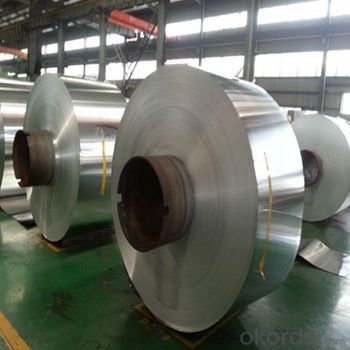
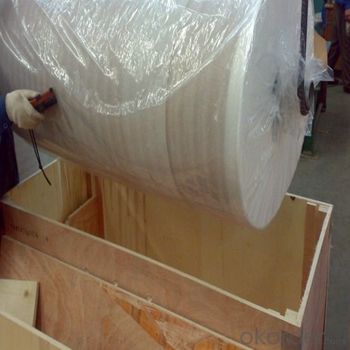
4.Aluminum Foil Mylar Specification
TYPICAL PHYSICAL PROPERTIES:
Name:AL+LDPE | |||
Structure | Thickness(mic) | Weight(g/m2) | Yield(m2/kg) |
AL7+ LDPE12 | 21mic | 36 | |
AL7+ LDPE15 | 24 mic | 39 | |
AL9+ LDPE12 | 23mic | 43 | 23 |
AL9 +LDPE15 | 26mic | 48 | 21 |
AL9 +LDPE19 | 30mic | 54 | 19 |
AL9 +LDPE23 | 34mic | 60 | 17 |
AL12 +LDPE12 | 26mic | 52 | 19 |
AL12 +LDPE15 | 29mic | 56 | 18 |
AL12 +LDPE19 | 33mic | 62 | 16 |
AL12 +LDPE23 | 37mic | 67 | 15 |
AL12 +LDPE36 | 50mic | 87 | 12 |
AL15 +LDPE19 | 36mic | 70 | 14 |
AL25 +LDPE12 | 39mic | 87 | 12 |
AL40 +LDPE36 | 78mic | 161 | 6 |
AL50 +LDPE12 | 64mic | 154 | 6 |
PROPERTIES | UNIT | VALUE | TEST METHOD |
Basic weight | gsm | 80 | ASTM D646 |
Tensile strength: M. D. X. D. | N/25mm | 95 50 | ASTM C1136 |
Burst strength | N | 25 | ASTM D774 |
Reflectivity of foil surface | % | 95 | ---------- |
Temp. Resistance | -29°C +66°C | No change keep soft | ASTM C1263 |
Water vapor permeance | ng/N.s | 1.15 | ASTM E-96 |
Water Soak Test | 24hrs | No delamination | ---------- |
Width: 1.0m, 1.2m, 1.25 m, 1.30, 1.37m
Length: 200m, 500m, 1000m, 2500m, 2750m, 3300m
Core I.D.: 3"(76mm ±1), 72mm ±1
Based on order, special sizes are also available.
5.FAQ
What is the storage condition?
The products should be stored at room temperature and kept from wet and heat source.
It is essential, as with all pressure-sensitive tapes, that the surface to which the tape is applied must be clean, dry, and free of grease and oil.
The user should take test and do trial-application on the above products before coming into application so as to witness and ensure suitability for user’s special purpose and technique.
- Q: Is it possible to use aluminum foil with a reflective side for baking purposes? If yes, what is the method of using it?
- <p>Yes, aluminum foil facing can be used for baking. To use it, place the foil shiny side up on the baking sheet to reflect heat and promote even cooking. It can also be used to cover the food to prevent over-browning or to create a steaming effect, which can help in cooking delicate items. Remember to use it carefully as it can get very hot and can cause burns. Always handle with oven mitts and avoid direct contact with the foil.</p>
- Q: Is it safe and practical to reuse plastic food wrap materials after cleaning them?
- <p>Reusing food wrap materials after washing them is generally not recommended. Plastic wraps can lose their effectiveness as barriers against bacteria and air after one use. Washing them can also introduce bacteria and may not fully remove any residual food particles. For food safety and hygiene, it's better to use new, clean wraps each time.</p>
- Q: What are some alternative uses for old aluminum foil that are not commonly known?
- <p>Yes, there are several creative uses for old aluminum foil. You can use it to clean stubborn grime from pots and pans, as it can effectively scrape off burnt-on food without scratching surfaces. Aluminum foil can also be used to sharpen scissors by cutting through it multiple times. It can be fashioned into a fire starter for camping, as it retains sparks and heat well. Additionally, it can be used to create a makeshift funnel for pouring liquids or to wrap around stems of plants to protect them from frost. These are just a few of the many potential uses for old aluminum foil.</p>
- Q: Is it possible to use aluminum foil facing more than once for various purposes?
- <p>Yes, aluminum foil facing can be reused for multiple purposes. It is commonly reused for cooking, baking, and food storage due to its heat resistance and reflective properties. For instance, you can use it to cover dishes in the oven, line baking sheets, or wrap food for storage. However, it's important to check for any tears or punctures after each use, as these can compromise its effectiveness and potentially lead to椋熷搧瀹夊叏 issues. Additionally, while it can be reused, it's not recommended to use it indefinitely as its performance may degrade over time.</p>
- Q: What are the potential health risks associated with cooking food using aluminum foil?
- <p>Cooking with aluminum foil can potentially lead to the leaching of aluminum into the food, which may have health implications. While the body naturally eliminates small amounts of aluminum, excessive intake can be harmful. Aluminum has been linked to neurological disorders, including Alzheimer's disease, although the connection is not definitively proven. It's also important to note that the amount of aluminum that leaches into food during cooking is generally considered to be low. However, for those concerned about aluminum exposure, it's advisable to minimize the use of aluminum foil in cooking, especially for acidic foods which can increase the rate of aluminum leaching.</p>
- Q: Is it safe to reuse aluminum foil for food packaging purposes?
- <p>While it may be tempting to reuse aluminum foil for food packaging, it is generally not recommended due to hygiene and safety concerns. Recycled aluminum foil can harbor bacteria and other contaminants, which can be transferred to the food. Additionally, the foil can tear easily when reused, leading to potential food waste. It's best to use fresh aluminum foil each time to ensure food safety and maintain the integrity of your packaging.</p>
- Q: Is it safe and hygienic to repurpose a piece of aluminum foil that was previously used for wrapping food?
- <p>It is generally not recommended to reuse aluminum foil that has been in contact with food. Used foil can have residues of food, grease, and bacteria, which can contaminate new food items. Additionally, the foil can tear or become thin in areas, reducing its effectiveness and potentially allowing food to stick to previously used, contaminated areas. For椋熷搧瀹夊叏 and hygiene, it's best to use a fresh piece of aluminum foil each time.</p>
- Q: Is it safe to use aluminum foil facing material to cover food when microwaving?
- <p>No, it is not recommended to use aluminum foil facing to wrap food in the microwave. Aluminum foil can cause sparks and potentially start a fire due to the metal's conductive properties. It can also reflect microwaves, damaging the microwave's interior and potentially the appliance itself. Always use microwave-safe materials, such as microwave covers or wax paper, to cover food during microwaving.</p>
- Q: The user wants to know if they can reuse their old aluminum foil facing to create a new one if it gets damaged.
- <p>Yes, you can use your old aluminum foil facing to make a new one if it gets damaged. Simply clean the old foil facing thoroughly, ensuring all adhesive residue is removed. Then, cut a new piece of aluminum foil to the appropriate size and shape. Apply a thin layer of adhesive, such as construction adhesive or double-sided tape, to the back of the new foil. Press it firmly onto the old facing, ensuring a smooth and secure bond. Allow it to dry according to the adhesive's instructions before using. This can be a cost-effective way to extend the life of your foil facing.</p>
- Q: The user is asking if aluminum foil can be used as a replacement for tin foil in baking and grilling applications.
- <p>Yes, you can use aluminum foil as a substitute for tin foil in baking pans or grilling pans. Both aluminum and tin foil are commonly used for similar purposes, such as lining pans, wrapping food, and preventing food from sticking. Aluminum foil is more widely available and less expensive than tin foil. It conducts heat well and is non-toxic, making it a suitable alternative for most baking and grilling needs. However, note that aluminum may react with acidic foods, so it's best to avoid using it in such cases or to use a heavier gauge to minimize contact with the food.</p>
Send your message to us
Aluminum Foil Facing Flexible Ducts and Bubble Foil AL+PET+LDPE AL+PET
- Loading Port:
- Tianjin
- Payment Terms:
- TT OR LC
- Min Order Qty:
- 12 m²
- Supply Capability:
- 30000 m²/month
OKorder Service Pledge
OKorder Financial Service
Similar products
Hot products
Hot Searches
Related keywords
